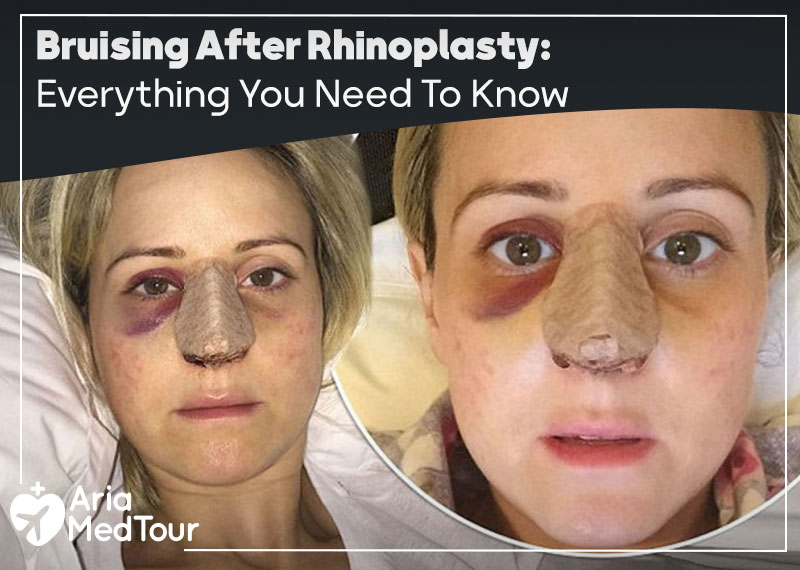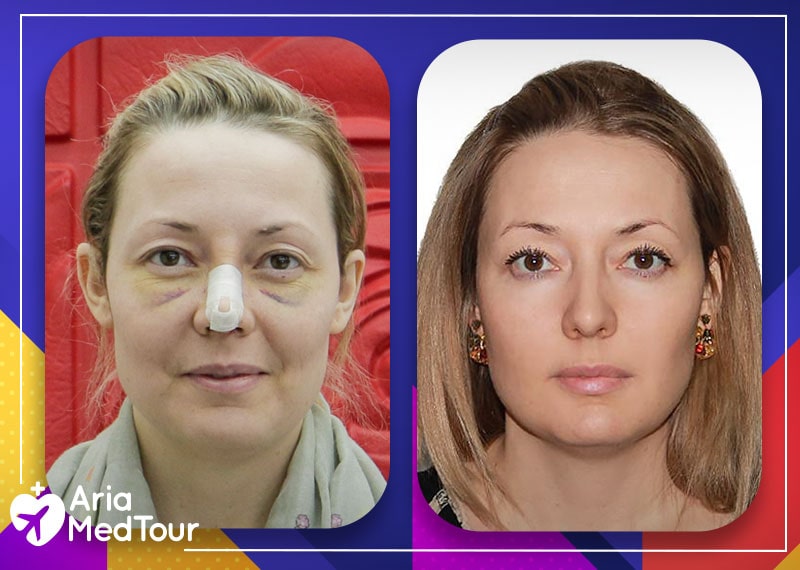Reading Time: 4 Min
Rhinoplasty is a complex surgical procedure, and as a result, it is not unusual for patients to experience bruising after nose job in the days following surgery. This occurs due to the pressure on the face during the surgery and the manipulation of tissues involved in reshaping the nose.
Bruising after rhinoplasty is a common complication that can persist for several days after the surgery, and in some cases, it can even last up to a few months. The extent of face after nose surgery bruising often depends on the patient’s skin type, surgical method, and post-operative care.
This article will discuss rhinoplasty bruising causes, areas involved, recovery timeline, and what to do to reduce the bruising.
Why do we experience bruising after rhinoplasty?
Bruising is common after any surgery. It may especially occur if the surgery is done on a delicate area with a lot of blood vessels like your nose. Therefore, a noticeable bruising is usually expected after rhinoplasty.
The most important reason for rhinoplasty bruising is the surgical procedure itself. It typically occurs because the surgical site is close to the blood vessels in the nose, and blood flow can be disrupted.
The small blood vessels around the surgical area break and leak blood which develops bruises, creating a red, swollen appearance.
However, several reasons may contribute to a more significant and extensive bruising after rhinoplasties, such as too much pressure or bleeding during the surgery, incorrect surgical technique, or complications from the surgery.
Rhinoplasty patients who experience significant bruising should see their doctor for evaluation and treatment.
Nose Job Packages
Surgery + Hotel + Visa
Transfer + Interpreter
Where does bruising appear after rhinoplasty?
Bruising can occur in a variety of locations on the face. This includes areas near the blood vessels in the nose and around the surgical site, typically where a lot of pressure is applied during nose job after surgery.
Bruises occur most commonly around the nose and eyes. They can also appear on the bridge of the nose, on the tip of the nose, around the nostrils, and the eyes.
The bruises are primarily red and swollen and can be caused by either direct trauma to the skin or by swelling from surgery.
Nose job bruising timeline
Rhinoplasty bruising stages can generally be expected to last for around two weeks. However, it is essential to be aware that this timeframe can vary depending on several factors, including the severity of the bruising and your physiology.
In most cases, milder bruising will usually subside within a few days, while more severe bruising may take up to a week or more to heal.

Bruising After Nose Job (Recovery Time and Bruise Colors): The color under the curve represents the main bruise color in each time.
Nose job bruising recovery stages
After rhinoplasty surgery, the bruising that initially appears will subsequently hide in the shade of reddish blood. Because of this, the redness in the bruising may not necessarily manifest until the next day.
Bruises will become more noticeable 2 to 3 days after the initial swelling. The discoloration will then be quite dark, and it might be purple, blue, or black and will remain dark for some days.
The body begins to repair itself two days after surgery, and the healing of bruising will show itself after several days. The fading may be noticeable after a day or two of massive bruising. The fading bruise will gradually change to a duller green shade. As it wears off, it will become greener in color.
Bruises can appear in brown, yellow, or green colors after one week to 10 days. While they heal, the bruises continue to fade. In most cases, bruises may disappear in as little as two to three weeks. While it may take a bit longer for some cases with extensive bruising, patients with mild bruising will get rid of it in less than two weeks.
It’s also normal to experience eye swelling after rhinoplasty, which usually peaks within the first 48 hours and then gradually subsides as the bruising heals.
How to reduce bruising after rhinoplasty
There is no surefire way to prevent bruising after rhinoplasty, but there are a number of things that you can do to help ensure that healing goes as smoothly as possible. Be sure to take advantage of all rhinoplasty post surgery care options available to you.
Here are some of the most important tips for helping you reduce bruising and make it heal more quickly.
- Make sure to keep your head elevated and avoid excessive activity until the swelling decreases significantly.
- Try not to put any pressure on your nose while it heals. It means avoiding heavy lifting or using facial muscles for too long.
- Keep yourself hydrated, as this will help reduce inflammation in the nose area.
- Use compression garments to reduce swelling and pain
- And finally, seek professional advice from your specialist about how best to manage your healing process.
If you experience excessive pain or discomfort, do not hesitate to ask your doctor for help.
Related Articles
Feel free to express your opinions or ask your questions regarding the article








is all before after photos in this article done by yourself? the photo of this girl had nose surgery in this article?
Yes, she was AriaMedTour’s nose job patient last year.
she had big change in her face
I’m 2 weeks after rhinoplasty, and the bruising around my eyes still looks pretty dark. Is this normal for the bruising after rhinoplasty timeline, or should I be concerned?
Hi Samantha, at 2 weeks after rhinoplasty, mild discoloration can still be visible depending on your skin type and recovery rate. The typical rhinoplasty bruising timeline ranges between 10 to 14 days, and most patients notice a major improvement in the face after nose surgery by the third week. Cold compresses and proper rest can help speed up the healing.
I had my nose job after surgery last week and still notice some eye swelling after rhinoplasty. Is it part of the rhinoplasty bruising stages or something I should report to my surgeon?
Hi Adam, slight eye swelling after rhinoplasty is a common part of the early rhinoplasty bruising stages. Swelling and bruising usually peak during the first 3–4 days and gradually subside after one week. Continue using cold compresses and keep your head elevated while sleeping — this helps the post nose surgery swelling resolve faster.
Many of my patients ask about the difference between rhinoplasty bruising and septoplasty bruising. Are the recovery timelines similar, or is one generally worse?
Thank you, Dr. Becker. Generally, septoplasty bruising is milder because bone structure is not significantly altered, while rhinoplasty bruising tends to be more pronounced due to manipulation of nasal bones. However, both follow a similar healing pattern, and proper postoperative care minimizes both bruising after septoplasty and bruising after rhinoplasty.
I’m from Spain and had surgery in Tehran. Could you tell me how long does bruising last after rhinoplasty and what’s the normal nose bruise healing time?
Hi Lucía, bruising typically lasts 7–14 days depending on your skin type and the extent of surgery. The average nose bruise healing time or bruised nose healing time is around two weeks. You can expect your face after nose job to look significantly better by the third week, though complete healing can take up to a month.
Some patients worry about the post nose job swelling and bruising after nose job. What’s the best way to explain that recovery period to them?
My sister just had a septoplasty and still has a bit of purple under her eyes. Could this be part of bruising after septoplasty or a sign of something wrong?
Hi Hannah, it helps to show them the bruising after rhinoplasty timeline and photos of gradual improvement. Patients often see the most change during the first two weeks. You can explain that bruising after nose surgery is temporary, and by week three, the majority of swelling and discoloration fade significantly.
I’m documenting my post nose surgery recovery for my followers. Can you explain how long does bruising last after nose job and what patients should expect during the rhinoplasty post surgery phase?
Hi Daniel, some bruising after septoplasty is completely normal. It usually fades within a week. Since septoplasty bruising is generally milder than after cosmetic rhinoplasty, as long as the swelling is decreasing and there’s no pain or infection, there’s nothing to worry about.
Great article, thank you for sharing these insights! I’ve tested many methods for building backlinks, and what really worked for me was using AI-powered automation. With us, we can scale link building in a safe and efficient way. It’s amazing to see how much time this saves compared to manual outreach. https://seoexpertebamberg.de/
Thanks, dear friend. We are glad that you used our content and shared your opinion with us…
Great article! I really appreciate the clear insights you shared – it shows true expertise. As someone working in this field, I see the importance of strong web presence every day. That’s exactly what I do at https://webdesignfreelancerhamburg.de/ where I help businesses in Hamburg with modern, conversion-focused web design. Thanks for the valuable content!
Thank you for your comment dear, We are glad that you are reading and sharing with us…